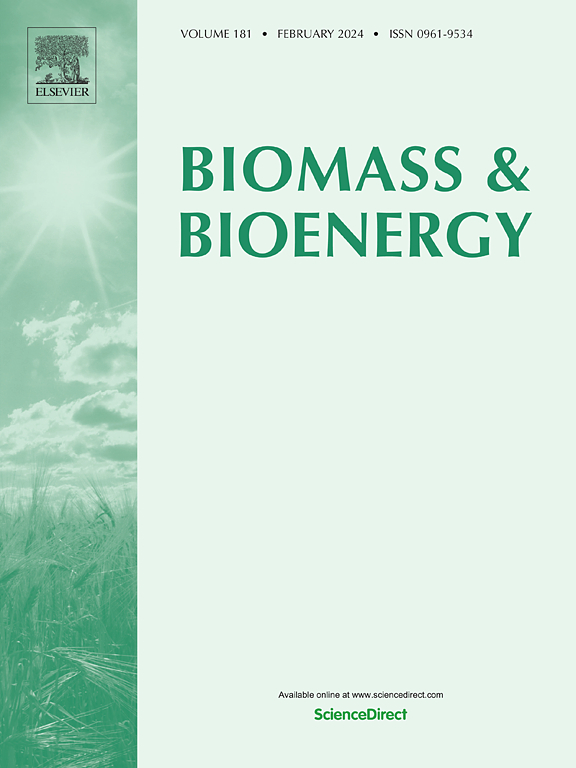Use of methanol as a promoter for ammonia combustion
IF 5.8
2区 生物学
Q1 AGRICULTURAL ENGINEERING
引用次数: 0
Abstract
This work aims to study the oxidation of ammonia and methanol mixtures (NH3/CH3OH). For this purpose, laboratory experiments were conducted using a quartz flow reactor at atmospheric pressure, in a temperature range of 875–1425 K. The oxygen excess ratio (λ) and the NH3/CH3OH ratio were modified during the experiments. The experimental results have been simulated with a literature-based kinetic mechanism. The results show that the presence of CH3OH and the oxygen excess ratio affect the conversion of NH3, shifting its oxidation to lower temperatures as these variables increase. The oxidation of both fuels was slightly boosted with increasing CH3OH concentration. The λ study showed that the fuel-lean conditions accelerate NH3 oxidation at lower temperatures whereas do not have the same effect on CH3OH oxidation. The H radical concentration significantly influences fuel consumption, especially in reactions involving CH3OH and NH2, and it is also key for inhibition processes. CH3OH was found to initiate NH3 reactions, with strong competition for OH radicals between the two fuels. Nevertheless, methanol helps reduce ammonia's oxidation temperature. CH2OH was identified as the predominant species following H-abstraction from CH3OH. In the NH3/CH3OH ratio studies, increasing methanol concentration lowered the oxidation temperature of both fuels, with a temperature difference of up to 150 K observed for NH3/CH3OH ratios from 0.6 to 10. Increasing methanol concentration for a given NH3 value also shifted the prominence of secondary reaction pathways, further influencing the overall oxidation process.

使用甲醇作为氨燃烧的促进剂
这项工作旨在研究氨和甲醇混合物(NH3/CH3OH)的氧化。为此,在常压下,在875-1425 K的温度范围内,使用石英流反应器进行了实验室实验。在实验过程中对氧过量比(λ)和NH3/CH3OH比进行了修正。对实验结果进行了基于文献的动力学机理模拟。结果表明,CH3OH的存在和氧过量比影响NH3的转化,随着这些变量的增加,NH3的氧化向较低的温度转移。随着CH3OH浓度的增加,两种燃料的氧化作用略有增强。λ研究表明,燃料稀薄条件在较低温度下加速了NH3的氧化,而对CH3OH的氧化没有相同的影响。H自由基浓度显著影响燃料消耗,特别是在涉及CH3OH和NH2的反应中,也是抑制过程的关键。研究发现,CH3OH可引发NH3反应,两种燃料对OH自由基的竞争非常激烈。然而,甲醇有助于降低氨的氧化温度。从CH3OH中提取h后,确定CH2OH为优势种。在NH3/CH3OH比研究中,增加甲醇浓度降低了两种燃料的氧化温度,NH3/CH3OH比为0.6至10时,观察到的温差高达150 K。在一定的NH3值下,增加甲醇浓度也会改变二次反应路径的重点,进一步影响整个氧化过程。
本文章由计算机程序翻译,如有差异,请以英文原文为准。
求助全文
约1分钟内获得全文
求助全文
来源期刊

Biomass & Bioenergy
工程技术-能源与燃料
CiteScore
11.50
自引率
3.30%
发文量
258
审稿时长
60 days
期刊介绍:
Biomass & Bioenergy is an international journal publishing original research papers and short communications, review articles and case studies on biological resources, chemical and biological processes, and biomass products for new renewable sources of energy and materials.
The scope of the journal extends to the environmental, management and economic aspects of biomass and bioenergy.
Key areas covered by the journal:
• Biomass: sources, energy crop production processes, genetic improvements, composition. Please note that research on these biomass subjects must be linked directly to bioenergy generation.
• Biological Residues: residues/rests from agricultural production, forestry and plantations (palm, sugar etc), processing industries, and municipal sources (MSW). Papers on the use of biomass residues through innovative processes/technological novelty and/or consideration of feedstock/system sustainability (or unsustainability) are welcomed. However waste treatment processes and pollution control or mitigation which are only tangentially related to bioenergy are not in the scope of the journal, as they are more suited to publications in the environmental arena. Papers that describe conventional waste streams (ie well described in existing literature) that do not empirically address ''new'' added value from the process are not suitable for submission to the journal.
• Bioenergy Processes: fermentations, thermochemical conversions, liquid and gaseous fuels, and petrochemical substitutes
• Bioenergy Utilization: direct combustion, gasification, electricity production, chemical processes, and by-product remediation
• Biomass and the Environment: carbon cycle, the net energy efficiency of bioenergy systems, assessment of sustainability, and biodiversity issues.
 求助内容:
求助内容: 应助结果提醒方式:
应助结果提醒方式:


